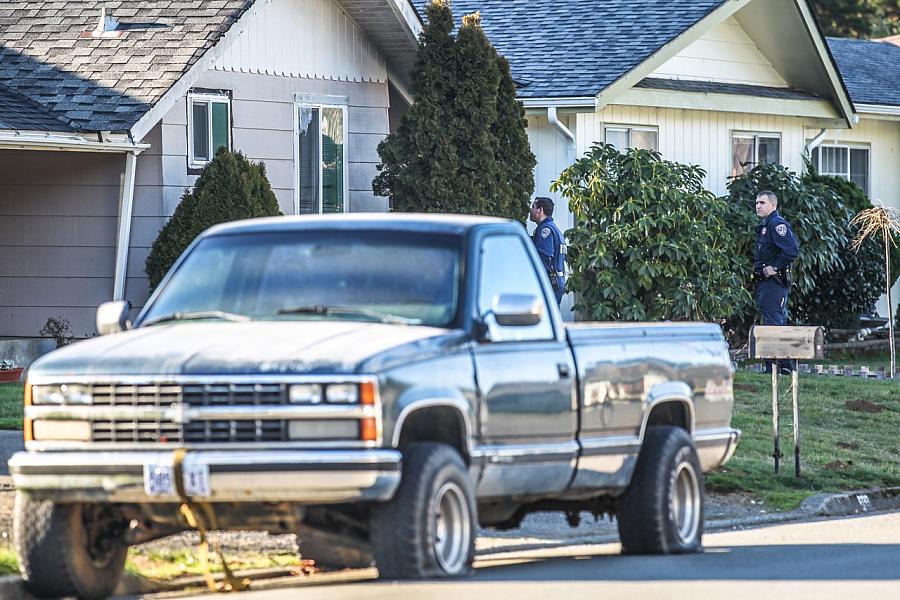The aftermath: Reporting on the rise of domestic violence in rural California

Local police respond to a call in Del Norte County, CA, photo by Del Norte Triplicate/Bryant Anderson
The calls come in every day.
“Children crying in the street on 9th and D. Domestic disturbance reported.”
A few hours later: “She was pulled out by her hair and thrown down” on Starfish Way.
Then, that night the sheriff’s office dispatcher was connected to another address, where “Somebody called, but nobody spoke."
These nightmarish glimpses into an endemic problem in rural Northern California crackle across the scanner regularly at the Del Norte Triplicate, a thrice-weekly newspaper serving a community with highest rate of domestic violence reports to police in the state.
Del Norte County is a sprawling landscape dotted by famously large redwood trees, small towns and unincorporated communities, tribal reservations and other areas where jurisdictional overlap makes policing problematic as social problems stemming from multi-generational poverty run rampant.
While the number of reported domestic violence incidents reported statewide is in decline, it has skyrocketed here, increasing five-fold between 2010 and 2011, then doubling again by 2012, when local law enforcement agencies received over 1,000 calls, according to the latest statistics available from the state’s Department of Justice. As a reporter who checks these call logs regularly, I have seen firsthand that many times instances of domestic violence are categorized as assaults, disturbances or otherwise not recorded in a way they would be reflected in statewide databases.
Meanwhile, calling for help is just the beginning of making a break.
For more than 1,000 square miles, there is but one temporary shelter for people who decide to flee from an abusive relationship.
Its current manager is Shelagh Carrick. She began as a volunteer at Harrington House seven years ago, advocating for victims 21 nights at a time, the maximum continuous housing this shelter can offer.
Unlike many emergency housing programs for families experiencing domestic violence, Harrington House’s location is no secret. The community is just too small for it to be, Carrick explained.
People she works with often face a total loss of income, a challenge that can quickly spiral into homelessness and terrible health outcomes.
As the number of people Carrick sees at the shelter explodes, she said the stereotypes and the stigma associated with reporting domestic violence have stayed the same.
"The number one stereotype I encounter is --"So, why did she stay? She must like it." A lot of women give up because they are in trauma and they are being re-traumatized on a consistent basis,” she said.
After reporting abuse, many victims must navigate complex systems to get legal protection, housing and social assistance. These services can be vital for making a successful break from a bad relationship and the bad health outcomes associated with it, such as death. Yet, how accessible are these services to residents that are often dependent on abusers for income and transportation?
“It would open a lot of eyes if you showed exactly what it takes to go from the decision to end that relationship and what all the consequences are, to independence and safety,” Carrick said.
“Someone can leave after the first event, or it can range all the way to 14 times. That is usually the most times someone tries to leave before they are murdered,” Carrick said.
Through the fellowship I will explore the health of domestic violence victims and their families in rural areas, as well as the systemic responses of agencies addressing domestic violence in Del Norte County and surrounding tribal lands.
Speaking with victims, advocates, law enforcement, prosecutors, social workers, judges and perpetrators, the goal is to explore what factors contribute to domestic violence occurring, and if these factors can actually be compounded in the wake of reporting an assault.
Other questions include:
How are the communities in California’s most northern reaches responding to victims of domestic violence?
Will recent changes to the Violence Against Women Act have an impact on prosecuting offenders on tribal reservations, regardless of ethnicity?
Of some 520,000 acres once occupied by the Yurok people, California largest native tribe, some 90 percent were taken away through the passage of state and federal laws, sanction of genocide and creation of reservations, dating from the 1848 Gold Rush to the Hoopa-Yurok Settlement Act of 1988.
Today, “Indian tribal courts do not have inherent criminal jurisdiction to try and to punish non-Indians, and hence may not assume such jurisdiction unless specifically authorized to do so by Congress,” according to the landmark 1978 Oliphant U.S. Supreme Court decision.
Starting next month, tribal courts with the resources to do so will be able to pursue domestic violence cases involving non-Native Americans, due to congressional amendments to the Violence Against Women Act in 2013.
At least one Fellowship story will address the response to and treatment of domestic violence on the Yurok reservation, where a Domestic Violence/Sexual Assault Program asks why the problem persists and how this community can begin to heal.

